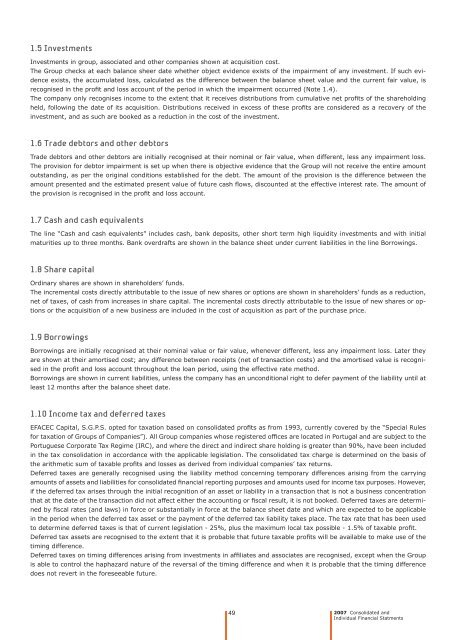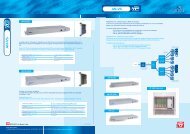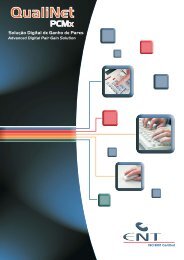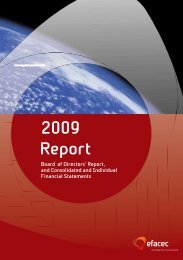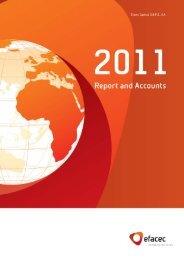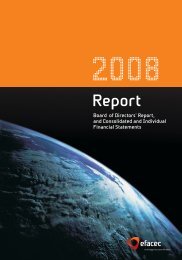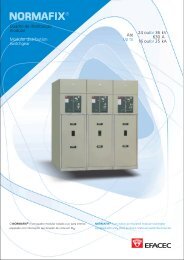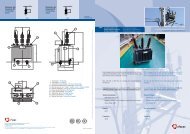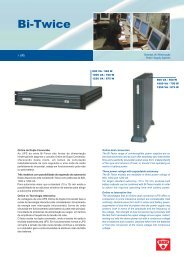Notes to the Financial Statements - Efacec
Notes to the Financial Statements - Efacec
Notes to the Financial Statements - Efacec
You also want an ePaper? Increase the reach of your titles
YUMPU automatically turns print PDFs into web optimized ePapers that Google loves.
1.5 Investments<br />
Investments in group, associated and o<strong>the</strong>r companies shown at acquisition cost.<br />
The Group checks at each balance sheer date whe<strong>the</strong>r object evidence exists of <strong>the</strong> impairment of any investment. If such evidence<br />
exists, <strong>the</strong> accumulated loss, calculated as <strong>the</strong> difference between <strong>the</strong> balance sheet value and <strong>the</strong> current fair value, is<br />
recognised in <strong>the</strong> profi t and loss account of <strong>the</strong> period in which <strong>the</strong> impairment occurred (Note 1.4).<br />
The company only recognises income <strong>to</strong> <strong>the</strong> extent that it receives distributions from cumulative net profi ts of <strong>the</strong> shareholding<br />
held, following <strong>the</strong> date of its acquisition. Distributions received in excess of <strong>the</strong>se profi ts are considered as a recovery of <strong>the</strong><br />
investment, and as such are booked as a reduction in <strong>the</strong> cost of <strong>the</strong> investment.<br />
1.6 Trade deb<strong>to</strong>rs and o<strong>the</strong>r deb<strong>to</strong>rs<br />
Trade deb<strong>to</strong>rs and o<strong>the</strong>r deb<strong>to</strong>rs are initially recognised at <strong>the</strong>ir nominal or fair value, when different, less any impairment loss.<br />
The provision for deb<strong>to</strong>r impairment is set up when <strong>the</strong>re is objective evidence that <strong>the</strong> Group will not receive <strong>the</strong> entire amount<br />
outstanding, as per <strong>the</strong> original conditions established for <strong>the</strong> debt. The amount of <strong>the</strong> provision is <strong>the</strong> difference between <strong>the</strong><br />
amount presented and <strong>the</strong> estimated present value of future cash fl ows, discounted at <strong>the</strong> effective interest rate. The amount of<br />
<strong>the</strong> provision is recognised in <strong>the</strong> profi t and loss account.<br />
1.7 Cash and cash equivalents<br />
The line “Cash and cash equivalents” includes cash, bank deposits, o<strong>the</strong>r short term high liquidity investments and with initial<br />
maturities up <strong>to</strong> three months. Bank overdrafts are shown in <strong>the</strong> balance sheet under current liabilities in <strong>the</strong> line Borrowings.<br />
1.8 Share capital<br />
Ordinary shares are shown in shareholders’ funds.<br />
The incremental costs directly attributable <strong>to</strong> <strong>the</strong> issue of new shares or options are shown in shareholders’ funds as a reduction,<br />
net of taxes, of cash from increases in share capital. The incremental costs directly attributable <strong>to</strong> <strong>the</strong> issue of new shares or options<br />
or <strong>the</strong> acquisition of a new business are included in <strong>the</strong> cost of acquisition as part of <strong>the</strong> purchase price.<br />
1.9 Borrowings<br />
Borrowings are initially recognised at <strong>the</strong>ir nominal value or fair value, whenever different, less any impairment loss. Later <strong>the</strong>y<br />
are shown at <strong>the</strong>ir amortised cost; any difference between receipts (net of transaction costs) and <strong>the</strong> amortised value is recognised<br />
in <strong>the</strong> profi t and loss account throughout <strong>the</strong> loan period, using <strong>the</strong> effective rate method.<br />
Borrowings are shown in current liabilities, unless <strong>the</strong> company has an unconditional right <strong>to</strong> defer payment of <strong>the</strong> liability until at<br />
least 12 months after <strong>the</strong> balance sheet date.<br />
1.10 Income tax and deferred taxes<br />
EFACEC Capital, S.G.P.S. opted for taxation based on consolidated profi ts as from 1993, currently covered by <strong>the</strong> “Special Rules<br />
for taxation of Groups of Companies”). All Group companies whose registered offi ces are located in Portugal and are subject <strong>to</strong> <strong>the</strong><br />
Portuguese Corporate Tax Regime (IRC), and where <strong>the</strong> direct and indirect share holding is greater than 90%, have been included<br />
in <strong>the</strong> tax consolidation in accordance with <strong>the</strong> applicable legislation. The consolidated tax charge is determined on <strong>the</strong> basis of<br />
<strong>the</strong> arithmetic sum of taxable profi ts and losses as derived from individual companies’ tax returns.<br />
Deferred taxes are generally recognised using <strong>the</strong> liability method concerning temporary differences arising from <strong>the</strong> carrying<br />
amounts of assets and liabilities for consolidated fi nancial reporting purposes and amounts used for income tax purposes. However,<br />
if <strong>the</strong> deferred tax arises through <strong>the</strong> initial recognition of an asset or liability in a transaction that is not a business concentration<br />
that at <strong>the</strong> date of <strong>the</strong> transaction did not affect ei<strong>the</strong>r <strong>the</strong> accounting or fi scal result, it is not booked. Deferred taxes are determined<br />
by fi scal rates (and laws) in force or substantially in force at <strong>the</strong> balance sheet date and which are expected <strong>to</strong> be applicable<br />
in <strong>the</strong> period when <strong>the</strong> deferred tax asset or <strong>the</strong> payment of <strong>the</strong> deferred tax liability takes place. The tax rate that has been used<br />
<strong>to</strong> determine deferred taxes is that of current legislation - 25%, plus <strong>the</strong> maximum local tax possible - 1.5% of taxable profi t.<br />
Deferred tax assets are recognised <strong>to</strong> <strong>the</strong> extent that it is probable that future taxable profi ts will be available <strong>to</strong> make use of <strong>the</strong><br />
timing difference.<br />
Deferred taxes on timing differences arising from investments in affi liates and associates are recognised, except when <strong>the</strong> Group<br />
is able <strong>to</strong> control <strong>the</strong> haphazard nature of <strong>the</strong> reversal of <strong>the</strong> timing difference and when it is probable that <strong>the</strong> timing difference<br />
does not revert in <strong>the</strong> foreseeable future.<br />
49<br />
2007 Consolidated and<br />
Individual <strong>Financial</strong> Statments


